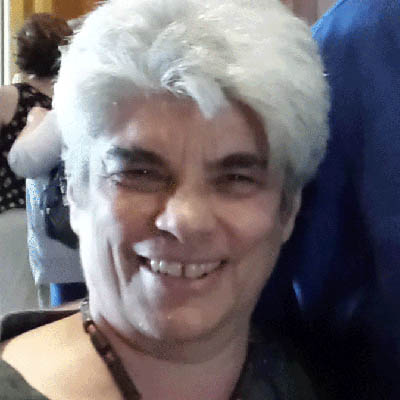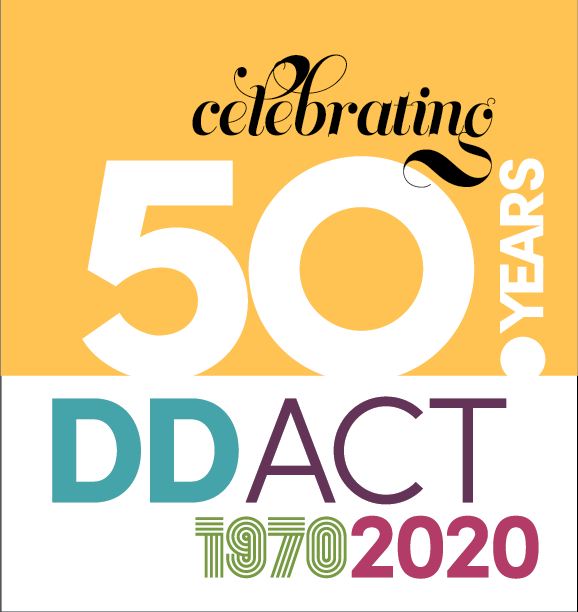An Interview with Elinor Gollay
Elinor Gollay guided the evolution of the definition of developmental disabilities during the first 20 years of the Developmental Disabilities Act.
By Jim Conroy, The Center for Outcome Analysis

Elinor Gollay

Ellie Gollay at 13

Jim Conroy

Jim Conroy at 23
Introduction
After 50 years since the passage of the Developmental Disabilities Act in 1970, it's a good idea to ask again, what exactly is a developmental disability? How did the definition become what it is today? We know that the term "developmental disabilities" was written on a cocktail napkin, brainstormed by Elizabeth Boggs and Elsie Helsel (both mothers and advocates). The first definition required onset in childhood, expectation of lifelong influence, and named three categories of disability specifically – the archaic term MR (intellectual disability), cerebral palsy, and epilepsy – and a fourth term more vaguely, neurological conditions requiring similar supports.
But that original definition seemed to exclude many people with disabilities who were not in those categories. This caused vigorous (to say the least) debate among advocates. The definition subsequently changed drastically over the 1970s. Very few of us working in this field lived through that period, and the tale is rarely told.
One person who was at the center of that cyclone was Dr. Elinor Gollay. After years of turmoil and strife, the besieged Congress mandated that the Administration on Developmental Disabilities undertake whatever actions were necessary to produce a less conflict-prone definition. Dr. Gollay led those efforts from positions in the private sector.

We interviewed Dr. Gollay by videoconference in her Portland home in November 2020. The way in which her work revolutionized the meaning of the term is pivotal in the history of developmental disabilities. This is the story of the origin of the so-called "functional definition of developmental disability." The story reveals a great deal about some oddities and quirks of America's present system of planning and services.
Disclaimer: This interview references an out-of-date term that is called intellectual disability today.
The first time you ever worked on a project to clarify the definition of developmental disabilities, tell us what that project was.
As I understand it, and I know some of this from Elizabeth Boggs, she put together the original definition, looking at the Social Security disability definition and the SSI rolls. Who were the people who had childhood disabilities, who were the most likely to end up in adulthood not able to work? What were the disabilities most likely to adversely impact someone's ability to be independent, in employment at least? Just looking at the numbers, Elizabeth put together MR (intellectual disability), cerebral palsy, and epilepsy. And then later was persuaded to add autism and other neurological disabilities. [For the 1975 amendments.]
Well I think that might have opened the door to Congressional hell, and Congress found itself barraged with people saying "Well what about Huntingdon's disease, what about deafness, what about blindness, and what about this, what about that?" "We're developmentally disabled, too." And so that was the way the impetus grew for contracting out this controversy. Basically, Congress said, "We're sick of this, so you tell us what we should put in the law." So, we got the contract [at Abt Associates consulting firm]. It was not a ton of money, about $100,000. We put together an advisory panel of people. My job was to put together a lot of background materials.
[That National Task Force on the Definition of Developmental Disabilities had 47 members, including Norman Lourie, Elizabeth Boggs, Elsie Helsel, Gunnar Dybwad, and Bob Gettings.]
We met three times, as I recall, to discuss what the definition should be. I think fairly early on, it was decided that it should be functional rather than categorical. There were a lot of discussions about, OK, it happens in childhood. When's childhood? What does that mean? What is a functional definition? What are the areas of functioning? What are the criteria for being sufficiently disabled? The easy way to describe it was the people who were being ignored, overlooked, and underserved. But that's not very precise.
And so the purpose of all the documents was to help the committee, because they're the ones that actually came up with it, come up with decisions. Should it be before age 18, or should it be 21, what should be the cutoff? And how do you make the determinations?
What issues about the definition were discussed and debated by the Task Force?
There was a lot of discussion about the purpose of the definition: What did it need to accomplish? How was it going to be used? What was the purpose of the Developmental Disabilities Act and how would the definition aid in the Act's goals?
There were intense discussions about some fundamental questions. For example, is there a difference between someone who is born with a disability and someone who acquires it later in life? What are those differences and are they important from a policy perspective? If they are important, in what ways? These discussions led to the specific discussion about the cut off age, with an understanding that any age cut off would be arbitrary and therefore on some level "unfair" because it would exclude some people who should, perhaps, be included.
But that's where the discussion returned to basic principles: An attempt to describe or define the group most likely to need a wide array of services from a wide array of agencies and organizations throughout their lives.
There were also many discussions about the functional areas and the number of areas in which someone would need to be "impaired" or "limited" to "qualify." Once again, this required a return to the core objectives and principles I just mentioned.
How was the final wording produced?
The actual wording was developed by the committee, with guidance from me and the people I had working for me and with me. So that's how I remember it. And then we did the report and I testified to Congress. And it got incorporated exactly as we recommended. All of which was great until it got misused.
How did it get misused?
State MR agencies were really the only large state agencies that didn't have a federal counterpart. There was the National Institutes of Mental Health [vast and well-funded], but there was only the President's Committee. There was no funding stream. I think that this definition kind of ended up filling the wrong gap. People wound up conflating developmental disability with MR all over again. The real concept was you could have a developmental disability and not have MR (an intellectual disability).
As I recall, there was intensive discussions about whether or not a cognitive impairment was a necessary aspect of a developmental disability. The decision clearly was that it was not. This is another reason why it was so misguided to turn state "MR" agencies into "DD" agencies. They were not set up to deal with people without a cognitive or intellectual deficit. So now what? Do they serve those people anyway and do it badly? Does the state now think they've "fixed it" and now serve the people who have a developmental disability but who do not have a cognitive deficit? I understand that the issue persists even today.
The Developmental Disabilities Act has evolved, and states have evolved along with it, but how do you see the 50 years of hope and change in the context of the definition?
I do think that the original fantasy about the new Federal Developmental Disabilities agency was that it would grow into a major source of funding for services at the state level. But by the time we redid the definition, as I recall, it was already clear that this was not going to happen. I don't know why it didn't happen. The Act is still only a tool to guide planning, values, and missions, not to fund services.
I don't think it's possible to discuss the developmental disabilities definition without making it very clear that it was not designed to be a diagnostic tool. It was NOT designed to determine if Johnny does or does not have a developmental disability. It was intended as a planning and policy tool to help state agencies figure out how best to serve an incredibly complex group of individuals who were or are going to need a wide array of services over their lifetimes. That's very different from a diagnostic tool to determine Johnny's status.
Anyway, that's my recollection.
References, Links
U.S. Department of Health & Human Services (May 1981). The Special Report on the Impact of the Change in the Definition of Developmental Disabilities (Mandated in P.L. 95-602, Sec. 502(b)(2).
https://mn.gov/mnddc/dd-act/documents/WEBB/81-DEF-RWEBB.pdf
Abt Associates (1977). Final Report of the National Task Force on the Definition of Developmental Disabilities. Report delivered to the Committee on Interstate and Foreign Commerce of the House of Representatives and the Committee on Human Resources of the Senate. https://mn.gov/mnddc/dd-act/documents/DEFINITIONS/77-DEF-GOL.PDF
(The Minority Report is in section 2.5.)
(There was a Minority Report submitted by 12 members of the National Task Force, who were primarily state officials responsible for everyday eligibility determination, and for allocating limited resources. They were concerned that figuring out who was "in" and who was not was made nearly impossible by what they felt was a vague functional definition.)
Morgan Systems, Inc. (1980). Operational Definition Of Developmental Disabilities: A Study of The Potential Impact of the Definition Recommended by The National Task Force on the Definition of Developmental Disabilities. Report to HEW by Morgan Consulting HEW-105-78-5003. https://mn.gov/mnddc/dd-act/documents/DEFINITIONS/80-DEF-GOL.PDF
Gollay, E. (1981). Operational Definition of Developmental Disabilities. Report to HEW by Gollay Associates. https://mn.gov/mnddc/dd-act/documents/DEFINITIONS/81-DSR-GOL.PDF




